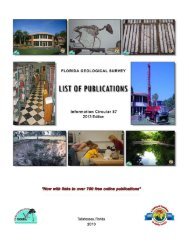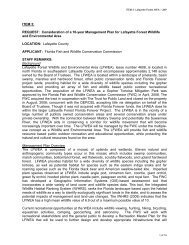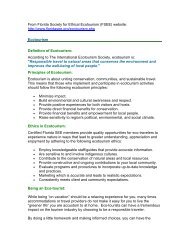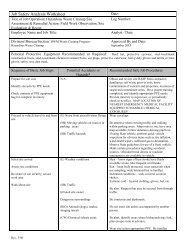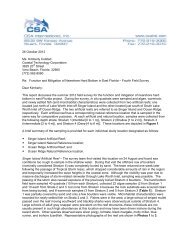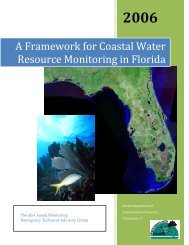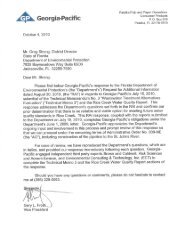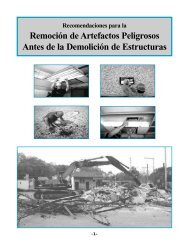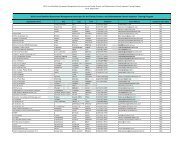Choctawhatchee River - Florida Department of Environmental ...
Choctawhatchee River - Florida Department of Environmental ...
Choctawhatchee River - Florida Department of Environmental ...
You also want an ePaper? Increase the reach of your titles
YUMPU automatically turns print PDFs into web optimized ePapers that Google loves.
Ecological and Morphological Significance <strong>of</strong> Old Growth Deadhead Logs in Northwest <strong>Florida</strong> Streams<br />
Donald Ray<br />
FDEP NWD Biologist<br />
Introduction<br />
A deadhead log was sampled with a dipnet on March<br />
11, 1999 to determine its habitat value. This<br />
monitoring was technical assistance for a Submerged<br />
Land and <strong>Environmental</strong> Resource Program permit<br />
application to remove these logs from state waters.<br />
The deadhead log sample site was located in the<br />
<strong>Choctawhatchee</strong> <strong>River</strong> (Lat 30° 54′3.1″ Long 85°52′<br />
33.7″) 2 miles southwest <strong>of</strong> Curry Ferry Landing near<br />
Izagora in Holmes County. The <strong>Choctawhatchee</strong><br />
<strong>River</strong> is designated by <strong>Florida</strong> Surface Water Quality<br />
Standards as Class III: Recreation, Propagation and<br />
Maintenance <strong>of</strong> a Healthy, Well-Balanced Population <strong>of</strong> Fish and Wildlife (FDEP 1996).<br />
The deadhead log (pictured above) was winched from a depth <strong>of</strong> 28 feet approximately 20 feet from the eastern<br />
bank on a high velocity (0.5 -1 meter/sec) outside erosional<br />
bend. Wallace and Benke (1984) found most wood is located<br />
near the erosional bank in meandering Coastal Plain streams.<br />
The log’s butt end faced upstream at an approximate 30° angle<br />
from the bank. This type <strong>of</strong> placement was ideal for stream bank<br />
protection (Rosgen 1993) as it deflected the current away from<br />
the bank back into the channel. This log was approximately 28<br />
feet long and 18 inches in diameter (butt end). Only the portion<br />
shown above could be sampled with a dipnet. Caddisfly nets<br />
and midge cases (dominated by Macrostenum and<br />
Rheotanytarsus)<br />
covered the visible<br />
portion <strong>of</strong> the log. The photograph on the left showed the caddisfly<br />
Macrostenum removed from its case excavated in the wood.<br />
Results and Discussion<br />
The results <strong>of</strong> the one-half dipnet sweep (~ 0.25 meter area) <strong>of</strong> the<br />
deadhead log indicated a highly productive and diverse aquatic<br />
macroinvertebrate community. The one-half dipnet sweep sample<br />
surpassed the thresholds established for a 4 sweep BioRecon <strong>of</strong><br />
multiple productive habitats in a 100 meter reach and BioRecons<br />
performed on 07/28-29/98 at <strong>Choctawhatchee</strong> <strong>River</strong> State Road 2<br />
(CR2), <strong>Choctawhatchee</strong> <strong>River</strong> US 90 (CR90), and <strong>Choctawhatchee</strong> <strong>River</strong> State Road 20 (CR20). The biometric<br />
value comparisons <strong>of</strong> the 4 sites and western panhandle thresholds are as follows:<br />
Biometrics Deadhead CR2 CR90 CR20 Thresholds<br />
Taxa Richness 37 28 22 17 > 24<br />
<strong>Florida</strong> Index 34 23 10 7 > 22<br />
EPT 24 11 6 6 > 17
To demonstrate deadhead log collection techniques, the permit applicant dove down, found the log and<br />
attached a cable and winched the butt end up 28 feet. For observation, the log was towed 10-15 feet toward the<br />
riverbank in order to get out <strong>of</strong> the strong current. After a few moments, mayflies, stoneflies, and caddisflies<br />
crawled from the portion <strong>of</strong> the wood extending out the water. Algae, liverworts, and mosses that provide<br />
additional habitat were also observed on the log. Winching and towing dislodged much <strong>of</strong> the log fauna most<br />
likely. Sampling was difficult due to the position <strong>of</strong> the log on the winch and the river current. Original plans<br />
were to scrape an entire deadhead log to capture the dislodged wildlife with a drift net. However, because <strong>of</strong> the<br />
depth <strong>of</strong> 28 feet and the strong swirling currents, the drift net capture <strong>of</strong> dislodged organisms was negligible.<br />
Despite these difficulties, an impressive diversity with high productivity was found on a small sample <strong>of</strong> the<br />
deadhead log.<br />
Erosion was reported to be a major concern <strong>of</strong> a TMDL minibasin study <strong>of</strong> the <strong>Choctawhatchee</strong> <strong>River</strong><br />
conducted during the summer <strong>of</strong> 1998 (FDEP 1999). This<br />
report (in draft) found most sites sampled suffered from<br />
elevated turbidity, habitat smothering and/or bank instability.<br />
Habitat assessments at <strong>Choctawhatchee</strong> <strong>River</strong> sites at US 90<br />
and State Road 2 found very poor substrate availability (2 to<br />
4 %). Wood debris substrate was only 1 to 3 %. Beschta and<br />
Platts (1986) reported that researchers have recognized that<br />
many streams are relatively “starved” <strong>of</strong> large organic<br />
material in regard to channel stability.Wood was found to be<br />
a major structural feature (43%) in a study <strong>of</strong> middle-order<br />
streams (fourth to seventh) <strong>of</strong> the southeastern Coastal Plain<br />
(Wallace and Benke 1984). Wallace and Benke reported that<br />
snag, or woody, habitat was the major stable substrate in<br />
these sandy-bottom streams and is a site <strong>of</strong> high invertebrate<br />
diversity and productivity. Additionally Wallace and Benke found wood is important to fishes, providing a rich<br />
source <strong>of</strong> invertebrate food, habitat, and cover. Benke et al (1979) reported several species <strong>of</strong> game fish forage<br />
almost exclusively on invertebrates associated with these woody substrates. The permit applicant had observed<br />
“deadhead logs covered with fish standing on their heads” as he pulled logs <strong>of</strong>f the bottom. Wood enhances the<br />
ability <strong>of</strong> a stream to process and conserve nutrient and energy inputs and has a major influence on the<br />
hydrodynamic behavior <strong>of</strong> the river (Wallace and Benke 1984). Wallace and Benke stated the “quantification <strong>of</strong><br />
wood habitat seems mandatory to assess past or potential impacts <strong>of</strong> snag removal on ecosystem processes in<br />
low-gradient streams”. Organic (woody) debris is the foodstuff <strong>of</strong> decomposers and some aquatic invertebrates<br />
(Gordon, McMahon, and Finlayson 1994). Gordon et. al reported that larger woody debris may play an<br />
important part in channel stabilization and removal may have long term effects on both a stream's ecology and<br />
morphology. A 6-year study (Megahan 1982) concluded that logs were the most important type <strong>of</strong> obstruction<br />
in stream channels because <strong>of</strong> their longevity and the large volume <strong>of</strong> sediments trapped behind them. Megahan’s<br />
study found only large stable obstructions remained in the channel during a high-flow year and fifteen times more<br />
sediment was stored behind obstruction than was delivered to the drainage outlets. FDEP has observed numerous<br />
snags flood deposited on top <strong>of</strong> the banks <strong>of</strong> the <strong>Choctawhatchee</strong> <strong>River</strong> (and other panhandle rivers). In contrast<br />
larger old growth timber such as the deadhead logs remained in the water as habitat. Gordon et. al stated “when<br />
organic debris no longer enters a stream the banks become unstable, streamside erosion accelerates and the<br />
channel topography can be smothered from the filling <strong>of</strong> pools and flattening <strong>of</strong> riffles. FDEP has observed<br />
limestone outcrop riffle habitat in the upper <strong>Choctawhatchee</strong> <strong>River</strong> buried by sediment. Lisle (1983, p.46) stated<br />
that riparian trees and large woody debris should be treated as if they “belong to the aquatic ecosystem”.<br />
Conclusions<br />
The upper <strong>Choctawhatchee</strong> <strong>River</strong> is listed as a <strong>Florida</strong> 303(d) waterbody because <strong>of</strong> its pollutant load. Water<br />
bodies on this list are required to have a Total Maximum Daily Load (TMDL) established to determine the amount<br />
<strong>of</strong> pollution reduction needed to restore the system to its designated use.<br />
A more diverse and productive wildlife community was found in this small dipnet sample <strong>of</strong> a deadhead log than<br />
bioassessments <strong>of</strong> 100 meter reaches <strong>of</strong> river at State Road 2, US 90, and State Road 2. Removal <strong>of</strong> the portions <strong>of</strong><br />
the remaining 2 to 4 % productive habitat (i.e. deadhead logs) could have substantial impact to the river’s fish and<br />
wildlife community.
Threatened fish species such as the Atlantic sturgeon and speckled chub utilize these habitats for food and cover.<br />
Erosion is a major concern in the <strong>Choctawhatchee</strong> <strong>River</strong> (FDEP 1999). Bank instability as shown in the above<br />
photograph accelerates when woody debris is removed from the stream channel. This streamside erosion not only<br />
directly affects property owners by losing land, but also fills the channel increasing the river basin’s flood potential.<br />
Restoration <strong>of</strong> historic concentrations <strong>of</strong> woody debris in the <strong>Choctawhatchee</strong> <strong>River</strong> would enhance fish and<br />
wildlife populations along with improving channel stability/stream morphology.<br />
References<br />
Benke, A.C., D. M. Gillespie, and F.K. Parrish., T.C. Van Arsdall, Jr., R.J. Hunter, and R.L. Henry, III. (1979).<br />
Biological basis for assessing impacts <strong>of</strong> channel modification: invertebrate production, drift, and fish feeding in a<br />
southeastern blackwater river. <strong>Environmental</strong> Resources Center Publication No. ERC 06-79, Georgia Institute <strong>of</strong><br />
Technology, Atlanta, Ga. 187 pp.<br />
Beschta, R.L. and Platts, W.S. (1986). Morphological features <strong>of</strong> small streams: significance and function, Water<br />
Resour. Bull., 22, 369-79.<br />
FDEP. 1996. <strong>Florida</strong> Administrative Codes 62-302.530, Criteria for Surface Water Quality Classifications. 73 pp.<br />
FDEP. 1999. (Draft) Minibasin study <strong>of</strong> selected TMDL streams and streams adjacent to chicken farms on the<br />
<strong>Choctawhatchee</strong> <strong>River</strong> Holmes, Washington and Walton Counties sampled July 1998. Unpaginated.<br />
Gordon, N.D., T.A. McMahon, B.L. Finlayson. (1994). Stream hydrology: an introduction for ecologist. John<br />
Wiley & Sons Ltd., New York, NY.: 526 pp.<br />
Lisle, T.E. (1986). Stabilization <strong>of</strong> a gravel channel by large streamside obstructions and bedrock bends, Jacoby<br />
Creek, northwestern California, Geol. Soc. <strong>of</strong> Am. Bull., 97, 999-1011.<br />
Megahan, W.F. (1982). Channel sediment storage behind obstructions in forested drainage basins draining the<br />
granitic bedrock <strong>of</strong> the Idaho Batholith, in Sediment Budgets and Routing in Forested Draining Basins (Eds. F.J.<br />
Swanson, F. J. Janda, T. Dunne, D.N. Swanston), pp. 114-21, Gen. Tech. Rep. PNW-141, US Dept <strong>of</strong><br />
Agriculture, Forest Service, Portland, Oregon.<br />
Rosgen, D.L. (1993): Applied Fluvial Geomorphology Training Manual. <strong>River</strong> Short Course, Wildland Hydrology,<br />
Pagosa Springs, CO.: 450 pp.<br />
Wallace, J.B., and A.C. Benke. 1984. Quantification <strong>of</strong> wood habitat in subtropical Coastal Plain streams. Can. J.<br />
Fish. Aquat. Sci. 41: 1643-1652.<br />
STORET Station 32020045<br />
Location <strong>Choctawhatchee</strong> <strong>River</strong> 2 miles SW <strong>of</strong> Curry Ferry Landing, Izagora<br />
Latitude: N30 54 ’ 3.1 ” Longitude: W85 52 ’ 33.7 ” Watershed / Basin Choctawhatechee <strong>River</strong>/ <strong>Choctawhatchee</strong> Bay<br />
Date/Time Collected 03/11/99 1300 -1330<br />
Collected & ID’ed By Donald Ray, Laurence Donelan, sorted by K. Ferguson<br />
Taxa found in 4 sweeps: 1 sweep <strong>of</strong> 0.25 meter <strong>of</strong> deadhead log types <strong>of</strong> habitats sampled; 12 hours picking & ID time.<br />
** Rare (1-3), Common (4-10), Abundant (11-100), Dominant (>100).
Taxa Fl Tally Abun<br />
Code<br />
Taxa Fl Tall<br />
y<br />
Abun<br />
Code<br />
Taxa Fl Tall<br />
y<br />
Diptera Trombidiformes Ephemeroptera<br />
Ceratopogonidae Acarina A Baetis sp. C<br />
Culicidae Oligochaeta C Baetisca sp.<br />
Empididae C Naiidae Caenis sp.<br />
Other Chironomidae A Tubificidae Callibaetis sp.<br />
Rheotanyarsus sp. 2 D Hirudinea Centroptilum sp.<br />
Simulium sp. 2 Pelecypoda Heptagenia sp.<br />
Stenochironomus sp. 2 A Corbicula sp. R Hexagenia sp. R<br />
Stratiomyidae Elliptio sp. Isonychia sp. R<br />
Tipulidae Pisidiidae Leptophlebia sp.<br />
Neoephemera sp.<br />
Stenacron sp. 1 R<br />
Gastropoda Megaloptera Stenonema sp. exiggum 2 C<br />
Ancylidae R Corydalus cornutus 2 R Tricorythodes sp. 1 R<br />
Elimia sp. 2 R Sialis sp. Eurylophella doria A<br />
Physella sp. Nigronia sp. Stenonem integrum R<br />
Planorbella sp. Hemiptera Ephemerillidae R<br />
Hydrobiidae Belostoma sp. Pentagenia sp. R<br />
Viviparus<br />
Corixidae<br />
Hydrometra sp. Plecoptera 2<br />
Pelocoris sp. Acroneuria sp. 2<br />
Pleidae Amphinemura sp. 2<br />
Ranatra sp. Hydroperla sp. 2<br />
Odonata Veliidae Isoperla sp. 2 R<br />
Argia sp. 2 R Leuctra sp. 2<br />
Boyeria sp. 2 Neoperla sp. 2 R<br />
Calopteryx sp. 2 Other (name groups) Paragnetina sp. 2<br />
Enallagma sp. COPEPODA Perlesta sp. 2 R<br />
Gomphus sp. 1 Perlinella sp. 2<br />
Hetaerina sp. 2 Pteronarcys sp. 2<br />
Ischurna sp. Taeniopteryx sp. 2 R<br />
Libellulidae Talloperla sp. 2<br />
Macromia sp. 2<br />
Neurocordulia sp. 1 Nemocapnia carolina 2 R<br />
Progomphus sp. 2 2<br />
2<br />
Trichoptera<br />
Anisocentropus sp.<br />
Coleoptera Brachycentrus sp. 2<br />
Ancyronyx variagatus Decapoda Cheumatopysche sp. 1<br />
Curculionidae Palaemonetes sp. 1 Chimarra sp. Molanna sp. 2 R<br />
Dineutes Procambarus sp. Diplectrona sp. Oecetis sp. R<br />
Dubiraphia sp. Hydroptila sp. 2 R<br />
Dytiscidae Hydropsyche sp. 2 R<br />
Gyretes sp. Amphipoda Lype diversa<br />
Microcylloepus sp. C Gammarus sp. 1 Macrostemum sp. 2 A<br />
Stenelmis sp. C Hyalella azteca Nectopysche sp. 1 R<br />
Crangonyx sp. Oecetis sp. cinerescens 1 R<br />
Oxyethira sp. 2<br />
Isopoda Polycentropus sp. 2<br />
Caecidotea (Asellus) 1 Triaenodes sp.<br />
Ceraclea sp.<br />
A<br />
Paranyctiophlax sp.<br />
R<br />
Column Total: FI/Taxa 8 9 Column Total: FI/Taxa 2 4 Column Total: FI/Taxa 24 24<br />
Thresholds for impairment rating: If 3metrics are > target values, site is<br />
BIOMETRICS Value Panhandle Healthy<br />
West East Peninsula NE If 2metrics are within target values, site is<br />
Site Total Taxa Richness 37 >24 >24 >18 >17 Suspect<br />
Site Total <strong>Florida</strong> Index 34 >22 >19 >10 >6 If less than 2 metrics are within target values, site is<br />
Site Total EPT 24 >17 >9 >4 >3 Impaired<br />
Abun<br />
Code





